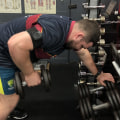Blood flow restriction (BFR) training has been reported to have significant benefits in local skeletal muscle, including increasing local muscle mass, strength and endurance while exercising with lower endurance. As a result, patients who are unable to perform traditional resistance training can benefit from this technique. The goal of occlusion training is to build strength. For healthy people, occlusion training will lead to muscle and strength gains.
Occlusion training also helps people recover from surgeries and injuries.
Blood flow
restriction training is great for strengthening muscles around arthritic hips or knees, but without causing joint pain. The main reason many athletes use bfr training is to stimulate muscle growth. Research suggests that BFR can significantly increase muscle size compared to traditional resistance training.So if you're looking to increase muscle size with light weights, BFR could be a big help. Studies have shown that athletes who used BFR at 30 percent of their one-rep maximum achieved more strength and muscle thickness gains compared to participants who traditionally trained at 80 percent of their one-rep maximum. Due to the low loads used with the restriction of blood flow and the limited muscle damage that occurs, athletes can benefit from decreased training loads, while obtaining a physiological stimulus for muscle adaptation. Similarly, athletes looking to increase their longevity in sports can benefit from reduced mechanical stress with BFR training.
Changes in muscle strength after blood flow restriction training are more closely related to the rapid increase in muscle hypertrophy than to neural adaptations. These adaptive responses can improve performance in a variety of athletic tasks, including maximum strength (5, 9, 1), countermotion jumping power (, peak and repeated sprint performance (5, 8, 1), agility performance (and aerobic shuttle race test (. Research data clearly demonstrate that low-load blood flow restriction training can improve physical performance markers in athletes who are already well-trained.
Blood flow restriction training
has been shown to help attenuate atrophy, improve hypertrophy, increase strength, and improve aerobic capacity, all in a low-load environment.However, even if you are manipulating blood flow, studies suggest that this type of training, in general, should not adversely affect the cardiovascular, endocrine or musculoskeletal systems. Blood flow restriction training is a technique that can be used to perform exercises with a reduced amount of blood flow to the arm or leg. By limiting blood flow to the muscles, users can work the muscles without putting excessive weight on the limb. Because you'll be lifting much less weight while training with restricted blood flow, the job may be easier on your joints.
This makes BFR training ideal for people who are unable to lift heavy weights due to injury, age or other factors. The muscles of the limbs and trunk can benefit from blood flow restriction training, which means that single or multi-joint exercises can be prescribed for training programs. However, that said, it is now recognized that blood flow restriction can improve adaptive responses to low-load endurance exercise and the observed adaptations depend both on the blood flow restriction stimulus itself and on the exercise protocol performed. One of the greatest benefits of BFR training is the ability to achieve the same results with low-intensity resistance exercises as those achieved with high-intensity resistance training (i.
Going for a walk with blood flow restriction (BFR) to improve maximum VO2, or lifting light weights with BFR to improve muscle mass may seem too good to be true. Smart Cuffs are designed specifically for home or clinical use and measure 4 inches wide for safe, low-pressure training. You are very familiar with the essential movements of strength training and have gone through different training variables before. It has been generally accepted that muscle hypertrophy requires high-intensity training using loads of at least 70% of the maximum or lower loads of 1 repetition (30-50% RM) until failure.
. .



Leave Reply